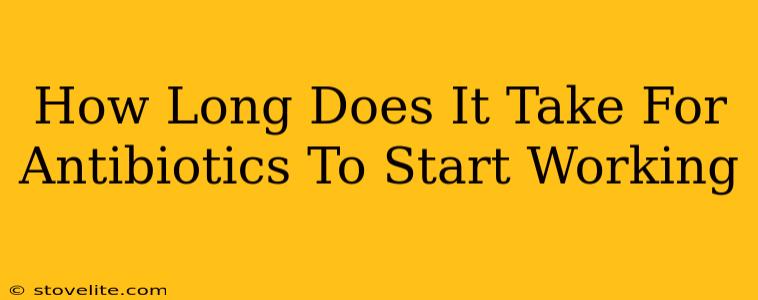It's a common question: How long does it take for antibiotics to start working? The truth is, there's no single answer. The timeframe varies depending on several factors, including the type of antibiotic, the infection being treated, and the individual's overall health. Let's dive deeper into this crucial aspect of antibiotic treatment.
Understanding the Timeline: When You'll Feel Better
While you might not feel immediate relief, antibiotics typically begin working within 24-48 hours. This doesn't mean you'll be completely symptom-free overnight. Instead, you should start to notice a gradual improvement in your symptoms. This could manifest as:
- Reduced fever: If you had a fever, it should begin to subside.
- Less pain or discomfort: The pain associated with your infection may lessen.
- Improved energy levels: You might feel less tired and sluggish.
- Decreased inflammation: Swelling or redness may decrease.
Important Note: It's crucial to remember that feeling better doesn't mean you should stop taking your antibiotics. Finishing the full course of antibiotics, even if you feel better, is vital to ensure the infection is completely eradicated. Stopping early can lead to the development of antibiotic-resistant bacteria, making future infections harder to treat.
Factors Affecting the Speed of Action
Several factors can influence how quickly antibiotics become effective:
1. Type of Antibiotic:
Different antibiotics work in different ways and at varying speeds. Some are fast-acting, while others require more time to build up sufficient levels in your system. Your doctor will prescribe the most appropriate antibiotic based on the type of infection you have.
2. Severity and Location of Infection:
A mild infection might respond more quickly than a severe or deeply seated infection. For example, a simple skin infection might clear up faster than pneumonia. The location of the infection also plays a role; infections in areas with poor blood flow may take longer to respond.
3. Individual Factors:
Your overall health, age, and immune system strength can influence the speed at which antibiotics work. People with weakened immune systems may require a longer course of treatment.
What to Do If You Don't See Improvement
If you haven't noticed any improvement in your symptoms after 48-72 hours, or if your condition worsens, contact your doctor immediately. This is crucial to rule out other potential causes, adjust the treatment plan, or consider alternative options. Never self-treat or alter your antibiotic dosage without consulting your doctor.
The Importance of Completing the Full Course
This cannot be stressed enough: always finish the entire course of antibiotics prescribed by your doctor, even if you start to feel better. Stopping early allows surviving bacteria to multiply, potentially leading to a recurrence of the infection and the development of antibiotic resistance. Antibiotic resistance is a significant public health threat, and responsible antibiotic use is essential to combat it.
Key Takeaways:
- Antibiotics typically start working within 24-48 hours, but you might not feel immediate relief.
- Gradual improvement in symptoms is a sign that the antibiotics are working.
- Finish the entire course of antibiotics, even if you feel better.
- Contact your doctor if you don't see improvement after 48-72 hours or if your condition worsens.
By understanding how long it takes for antibiotics to work and following your doctor's instructions, you can contribute to effective treatment and help prevent the spread of antibiotic-resistant bacteria. Remember, your doctor is the best resource for personalized advice regarding your specific situation.

